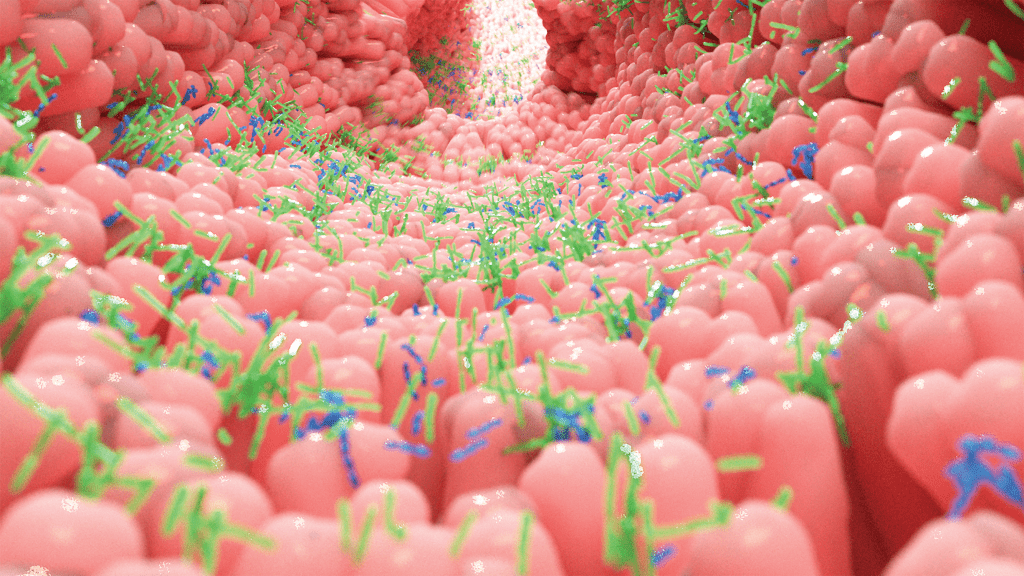Learn about the connections to improve care.
- The digestive system, skin, lungs and other parts of the body that interact with the environment are covered with bacteria, fungi, protozoa, and other microbes.
- Research in the past 20 years has shown the gut microbiome to be a key factor in the start and progression of cardiovascular disease, a variety of cancers, diabetes, dementia, allergy, depression, schizophrenia, and rheumatoid arthritis.
- Addition of probiotics to diet can make a dramatic change to health and immune function.
Nursing’s role in lifestyle medicine
Six steps to optimal nutrition care
- Describe the gut microbiome development process.
- Discuss how probiotics, prebiotics, and synbiotics impact the gut microbiome.
- Explain the connection between the gut microbiome and cardiovascular disease, type 2 diabetes, cancer, and mental health.
No relevant financial relationships were identified for any individuals with the ability to control content of the activity.
Expiration: 4/1/27
Our skin, scalp, mucous membranes, teeth, and digestive system are covered with symbiotic microorganisms we need for health. Some researchers describe the bacteria, fungi, protozoa, and other microbes in our digestive system (the gut microbiome) as the newest discovered body organ. Each person’s balance and mix of microbiota are unique, affected by diet, the environment, early life exposure, hygiene, geography, and even socioeconomic status.
Low levels of good microbes or high levels of harmful microbes create an imbalanced gut (dysbiosis). Environmental factors, genetics, lifestyle factors, medications, infectious pathogens, and dietary habits can trigger dysbiosis. Research demonstrates the connection between these symbiotic colonies and health. (See Microbiome development.)
Microbiome development
During pregnancy, a growing fetus exists in a relatively sterile environment. Once the amniotic sac ruptures, the infant’s exposure to microbes begins. If delivered vaginally, the infant is exposed to the microbiome of the vaginal canal, which becomes part of their own gut microbiome. Babies born by cesarean delivery who don’t have this exposure frequently are prescribed prophylactic antibiotics.
Some of the first microbes the baby is exposed to in the vaginal canal aid breastmilk digestion. Bacteria in the gut produce vitamin K, which aids blood clotting. Newborns don’t initially produce their own vitamin K, so they receive an interim shot until they can. Essential fatty acids needed for brain development result from bacteria-digesting fibers. As a child grows, the gut microbiome diversifies.
According to Wiertsema and colleagues, 70% to 80% of immune cells exist in the gut. The microbiome plays a significant role in immune function with intricate involvement in the development of both innate and adaptive immunity. Healthy microbes teach the immune response to distinguish between beneficial microbes and dangerous pathogens. Current research focuses on “seeding” infants’ mucous membranes with vaginal swabs to improve their microbiome; however, not enough evidence exists to change clinical practice.
Understanding how the gut microbiome affects overall health can help nurses make referrals for care and provide support with prescribed treatment (including dietary and lifestyle changes as well as prescribed supplements).
Microbiome research
The past 15 years have resulted in an explosion of research on the gut microbiome. The body needs more than 37 trillion microbes to protect it from pathogens, to break down essential nutrients, and to convert raw materials for proper immune function. According to Ivanova and colleagues, by square inch, our bodies are more microbiome than human and the average human fecal sample contains up to 700,000 bacterial genes. The human digestive tract consists of the mouth, esophagus, stomach, small intestine, and large intestine; however, most microbiome studies have focused on the bacterial genes of the large intestine.
Research indicates that human gut microbiome changes have a strong connection to many digestive health issues, including irritable bowel syndrome, inflammatory bowel disease, ulcerative colitis, Crohn’s disease, celiac disease, and colorectal cancer. It makes sense that an unbalanced gut microbiome influences digestive health; however, it affects so much more. For example, the gut microbiome appears to play a key role in various types of cancers, diabetes, dementia, allergy, depression, schizophrenia, and rheumatoid arthritis. It influences both the start of the disease and symptom intensity as the disease progresses.
The gut microbiome produces essential enzymes, neurotransmitters, and vitamins. For instance, Vitamin B1, required to convert carbohydrates to energy, is synthesized by gut microbes and absorbed into the bowel with the help of other microbes.
Many diseases associated with the gut microbiome are characterized by continual low-grade inflammation. The gut microbiome plays a significant role in triggering or calming the immune system’s inflammatory responses. For example, the microbes use fermentation of dietary nondigestible fiber to develop short-chain fatty acids (SCFAs), which have anticarcinogenic and anti-inflammatory properties. An essential balance of the microbiome either keeps the immune system in balance or impairs immune function, triggers inflammation, and leads to autoimmune disorders.
Cardiovascular disease and gut microbiome
Evidence points to a strong association between cardiovascular health and the gut microbiome. Alterations in the microbiome environment trigger a chain reaction of pathogenic effects. Dysbiosis results in increased incidence of atherosclerosis, inflammation, obesity, and insulin resistance, as well as platelet and blood lipid abnormalities. In addition, dysbiosis interferes with bile acid metabolism and SCFA modulation and can lead to overproduction of trimethylamine N-oxide (TMAO). The results include high cholesterol levels and atherosclerosis, inflammation, and various cardiovascular issues.
About one-fourth of the body’s cholesterol level is derived from dietary intake; the liver produces the rest. Cholesterol, essential for life, supports the function and structure of cell membranes. We need cholesterol to synthesize many hormones, bile acids, and vitamin D. In turn, bile acids aid cholesterol absorption, synthesis, and excretion. They also assist in the absorption of fats, nutrients, and fat-soluble vitamins and play a direct role in the body’s management of glucose, lipids, and energy metabolism. The presence of microbiota in the gut helps to maintain and protect bile acids. Consequently, dysbiosis alters the body’s cholesterol balance and affects serum cholesterol levels. A gut microbiome with plenty of Lactobacilli and Bifidobacterium has been specifically associated with lower cardiovascular risk.
Researchers have linked the presence of TMAO with an increased risk of cardiovascular disease. TMAO is a toxic end product produced by gut bacteria in the presence of certain foods, most notably red meat, eggs, and deep-sea fish. Increased production of TMAO modifies lipid levels and leads to an increased risk of coronary artery disease. Lactobacilli and Bifidobacterium inhibit the synthesis of TMAO.
SCFAs, metabolites produced in the colon by good anaerobic bacteria in the gut as a result of carbohydrate and fiber fermentation, facilitate several metabolic processes (synthesis of lipids, glucose uptake, and inflammatory response) and inhibit the growth of bad bacteria such as Salmonella and Escherichia coli. SCFAs also are associated with decreased serum cholesterol levels and lower risk of cardiovascular disease. Probiotics offer an inexpensive approach to decreasing serum cholesterol levels, thus reducing cardiovascular disease risk.
Type 2 diabetes and gut microbiome
High-fat, high-calorie, high-carbohydrate, and sedentary lifestyles can result in an inefficient and unhealthy microbiome and an increased risk for metabolic syndrome, type 2 diabetes, and obesity. Blood sugar instability, insulin resistance, and inflammation are the root causes of these conditions. Bacteroidetes and Firmicutes aid digestion and fermentation of indigestible dietary fibers, which produce SFCAs.
Current best practice in the treatment of type 2 diabetes includes optimal nutrition and a well-balanced diet. Fiber-rich diets and polyphenols (berries, nuts, olives) can benefit the microbiome composition by reducing inflammation, decreasing insulin resistance, and elevating glucagon and insulin levels. Treatment also can include a combination of probiotics, prebiotics, and synbiotics as well as antidiabetic drugs.
Probiotics improve glucose tolerance and provide additional benefits, such as decreased inflammation and improved sensitivity to insulin. Synbiotics, a combination of pre- and probiotics, have demonstrated improved metabolism of both lipids and glucose in individuals with type 2 diabetes. (See A treatment approach.)
A treatment approach
Evidence related to targeting the gut microbiome as a treatment approach with probiotics, prebiotics, and synbiotics has changed practice.


Cancer and gut microbiome
Western diets (typically high in animal fat and low in fiber) can affect gut bacteria colonies and diversity and increase the risk of cancer. Strong correlations exist between gut microbiome and the development of several cancers, including liver, colorectal, and pancreatic. Specific bacteria can trigger the development of some cancers; biomarkers in the gut microbiome can aid identification and even predict pancreatic and colorectal cancer.
Fecal matter has been used to assess possible biomarkers for cancer and cancer progression. Specific microbiota can contribute to the risk of malignancy and tumor development, as well as the efficacy of cancer treatment. The health of the gut microbiome also influences how the body metabolizes medications. Probiotics may help reduce the incidence of treatment side effects and improve the action of other dietary supplements used in cancer therapy.
Allergy and gut microbiome
Research shows a clear role for gut microbiome in the development of allergic conditions. An imbalance of gut microbiome has been linked to an increased risk of conditions such as asthma, atopic dermatitis, psoriasis, and eczema. Probiotic therapy, which can help decrease inflammation in the body, also can aid treatment of allergic asthma. Researchers have found that administering probiotics in combination with conventional asthma therapy to help alleviate asthma symptoms. In addition, studies have found that transplanting feces from mice with allergies can cause allergies in other mice by increasing immunoglobulin E levels. Dysbiosis precedes the development of sensitivities and also can have a role in treatment. More research will help clarify what this means for human health.
The hygiene hypothesis, which developed out of observing that children from large households have lower allergy rates, posits that lack of exposure to a variety of microbiota increases the risk for developing allergic conditions. Maternal prenatal exposure to pets, living in rural environments, and vaginal delivery are all associated with reduced allergies. Most studies to date have focused on the gut microbiome, but we also should consider skin or airway microbes and their role in allergy development.
Mental health and gut microbiome
According to the World Health Organization, one in every eight people lives with a mental health disorder. The gut microbiome has been implicated in triggering the development of mental health issues. According to Liu and colleagues, specific gut microbiota play a role in the production of serotonin, dopamine, norepinephrine, gamma-aminobutyric acid, and more than 60 other neurotransmitters. For example, microbes in the digestive system synthesize most of the body’s serotonin (many antidepressants target serotonin levels), which is involved in effective sleep as well as depression, bipolar disorder, and other mental health conditions. And dopamine is the neurotransmitter involved in schizophrenia.
Recently, probiotics have been integrated into treatment for depression, anxiety, and schizophrenia. Significant research also indicates that the improvement of digestive health with pre- and probiotics may benefit those on the autism spectrum.
Improving health
Diet and supplements significantly influence the balance and composition of the gut microbiome. Probiotics help maintain and enrich the health of many microbiota species. Evidence guides us through only a few specific probiotics, but many more species require research. A personalized nutrition plan serves as the best approach. Providers can recommend probiotics and synbiotics to aid weight management in those with overweight and obesity. For example, specific strains in the genus Lactobacillus and Bifidobacterium show the best results in reducing body weight.
Patients can ingest probiotics in foods, capsules, tablets, powders, and liquids. Unfortunately, many commercial probiotic products are poorly regulated, which can make it challenging for consumers to choose safe options. Foods provide the safest source of probiotics because they offer a variety of cultures; supplements shouldn’t be the first choice. Bifidobacterium and Lactobacillus, most commonly found in yogurt, have been used for the anti-inflammatory effects and treatment of constipation.
Probiotic strains include genus and species names. Lactobacillus acidophilus, the most common species, is found in live yogurt cultures. Other dairy products with probiotics include fermented dairy products, goat milk, ice cream, milk chocolates, whey cheese, cottage cheese, cheddar cheese, and buttermilk. Non-diary food sources include soy-based products, juices infused with probiotics, cereals, and nutrition bars. Fermented foods such as sauerkraut, kefir, and kimchi also contain probiotics. High-sugar, low-fiber diets can exacerbate intestinal bacterial overgrowth and result in GI symptoms. Choosing a low-fat, low-sugar, high-fiber diet can alter the gut microbiome in as little as a day.
Healthy choices
We require more research into how well diet or supplements work for patients with specific conditions. We also need more consistent manufacturing and reporting of probiotics sold as supplements. Once standardized microbiota therapies become available, healthcare providers will be able to suggest dosages and better discuss expected outcomes with patients.
As science uncovers more information on the details related to the importance of the gut microbiome, nurses can use this information to help guide patients in making the best choices for their health. You play a vital role in educating patients on strategies for maintaining a healthy balanced gut microbiome. Look for more education on this topic to add to your patient education toolbox.
The authors work at Austin Peay State University in Clarksville, Tennessee. Terri A. Clark is an associate professor and RN to BSN program facilitator. Kristen Butler is an associate professor. Debra Rose Wilson is a professor and Lenora C. Reuther Chair of Excellence.
American Nurse Journal. 2024; 19(4). Doi: 10.51256/ANJ042406
References
Arora A, Behl T, Sehgal A, et al. Unravelling the involvement of gut microbiota in type 2 diabetes mellitus. Life Sci. 2021;15:119311. doi:10.1016/j.lfs.2021.119311
Bunyavanich S, Berin MC. Food allergy and the microbiome: Current understandings and future directions. J Allergy Clin Immunol. 2019;144(6):1468-77. doi:10.1016/j.jaci.2019.10.019
Chrysostomou D, Roberts LA, Marchesi JR, Kinross JM. Gut microbiota modulation of efficacy and toxicity of cancer chemotherapy and immunotherapy. Gastroenterology. 2023;164(2):198-213. doi:10.1053/j.gastro.2022.10.018
Ivanova A, Yalovenko O, Dugan A. Human gut microbiome as an indicator of human health. Innovative Biosyst Bioeng. 2021;5(4):207-19. doi:10.20535/ibb.2021.5.4.244375
Jones RL. Gut microbiome as a potential biomarker of cancer risk in inflammatory bowel disease. Contemp Oncol. 2022;26(1):40-3. doi:10.5114/wo.2022.114537
Kazemian N, Mahmoudi M, Halperin F, Wu JC, Pakpour S. Gut microbiota and cardiovascular disease: Opportunities and challenges. Microbiome. 2020;8(1):36. doi:10.1186/s40168-020-00821-0
Liu A, Ma T, Xu N, et al. Adjunctive probiotics alleviate asthmatic symptoms via modulating the gut microbiome and serum metabolome. Microbiol Spectr. 2021;9(2):e0085921. doi:10.1128/Spectrum.00859-21
Lockwood MB, Green SJ. Clinical care is evolving: The microbiome for advanced practice nurses. J Am Assoc Nurse Pract. 2020;32(4):290-2. doi:10.1097/JXX.0000000000000379
Masenga SK, Hamooya B, Hangoma J, et al. Recent advances in modulation of cardiovascular disease by the gut microbiota. J Hum Hypertens. 2022;36(11):952-9. doi:10.1038/s41371-022-00698-6
Moriki D, Francino MP, Koumpagioti D, et al. The role of the gut microbiome in cow’s milk allergy: A clinical approach. Nutrients. 2022;14(21):4537. doi:10.3390/nu14214537
Musso P, Chiappini E, Bernardini R. Human microbiome and allergic diseases in children: Pathogenetic role and therapeutic options. Curr Pediatr Rev. 2020;16(2):89-94. doi:
10.2174/1573396315666191025110849
Sharma S, Tripathi P. Gut microbiome and type 2 diabetes: Where we are and where to go? J Nutr Biochem. 2019;63:101-8. doi:10.1016/j.jnutbio.2018.10.003
Sikalidis AK, Maykish A. The gut microbiome and type 2 diabetes mellitus: Discussing a complex relationship. Biomedicines 2020;8(1):8. doi:10.3390/biomedicines8010008
Turkalj M, Lipej M. Respiratory and gut microbiota in allergy and asthma. Cent European J Paediatr. 2019;15(1):37-45. doi:10.5457/p2005-114.228
Sung M, Choi Y, Park H, Huh CS. Gut microbiome characteristics in mothers and infants according to the presence of atopic dermatitis. Biomed Res Int. 2022:8145462. doi:10.1155/2022/8145462
Vourakis M, Mayer G, Rousseau G. The role of gut microbiota on cholesterol metabolism in atherosclerosis. Int J Mol Sci. 2021;22(15):8074. doi:10.3390/ijms22158074
Wiertsema SP, van Bergenhenegouwen J, Garssen J, Knippels LMJ. The interplay between the gut microbiome and the immune system in the context of infectious diseases throughout life and the role of nutrition in optimizing treatment strategies. Nutrients. 2021;13(3):886. doi:10.3390/nu13030886
Wilson DR. Psychoneuroimmunology. In: Helming MAB, Shields DA, Avino KM, Rosa WE, eds. Dossey & Keegan’s Holistic Nursing: A Handbook for Practice. 8th ed. New York City, NY: Jones and Bartlett Learning; 2022; 263-75.
World Health Organization. Mental Disorders. June 8, 2022. who.int/news-room/fact-sheets/detail/mental-disorders
Key words: microbiome, gut microbiome, probiotics



















3 Comments. Leave new
Thank you to the authors for this information – very relevant for nurses to use in talking with patients and families.
Very relevant information
Very helpful I am a diabetic myself.